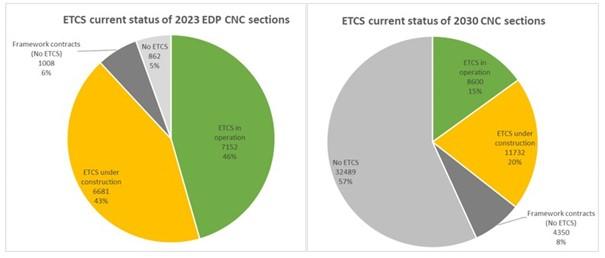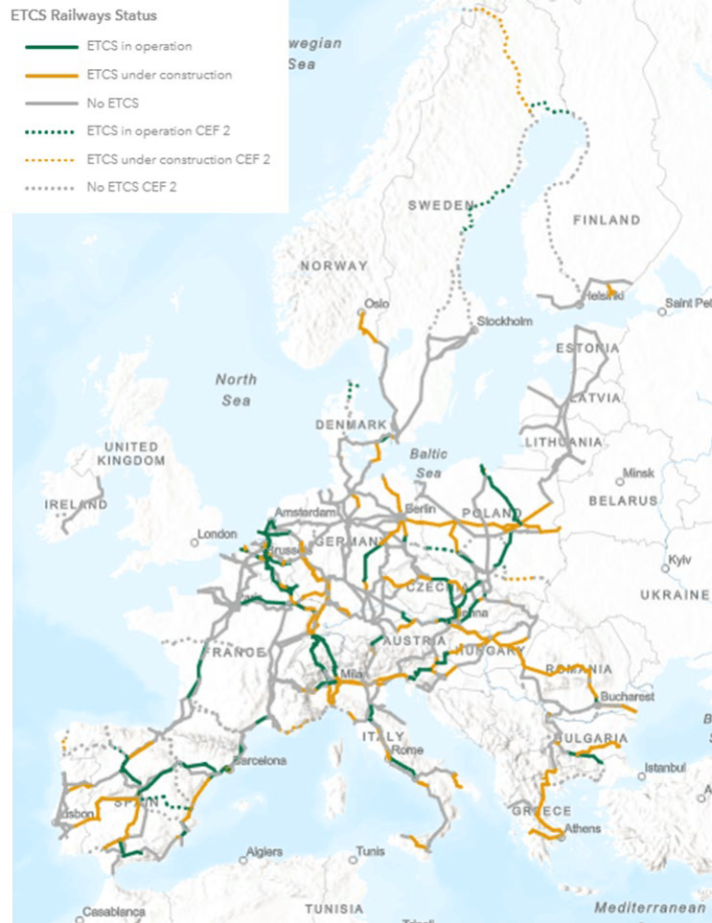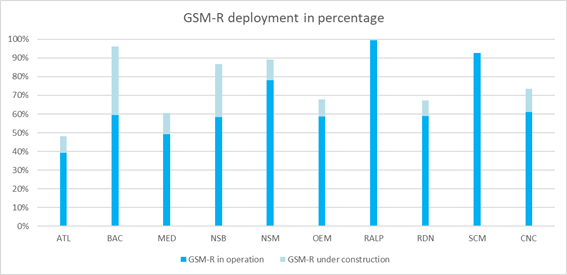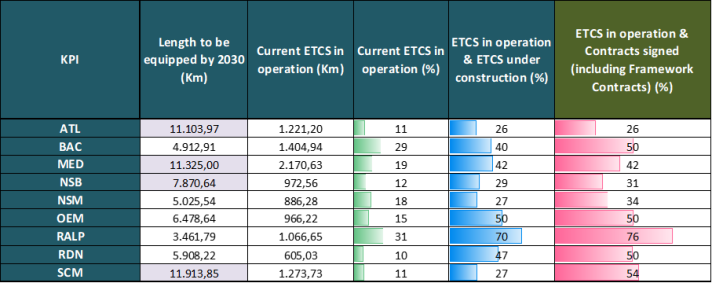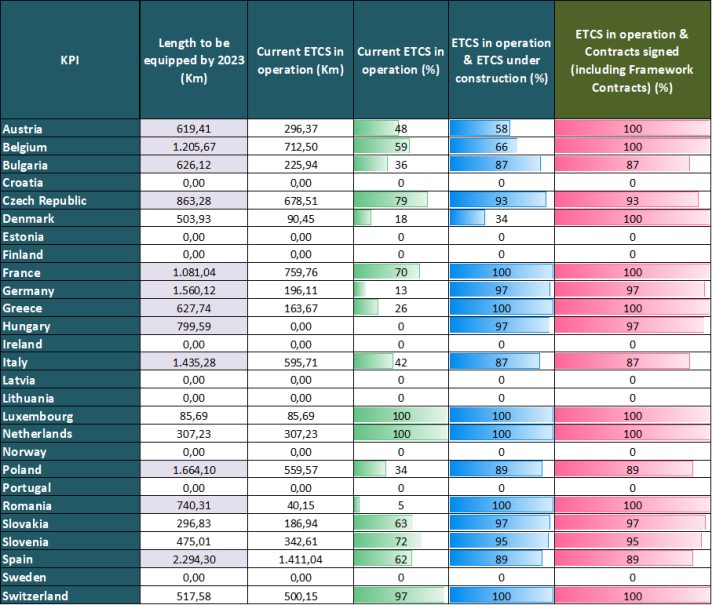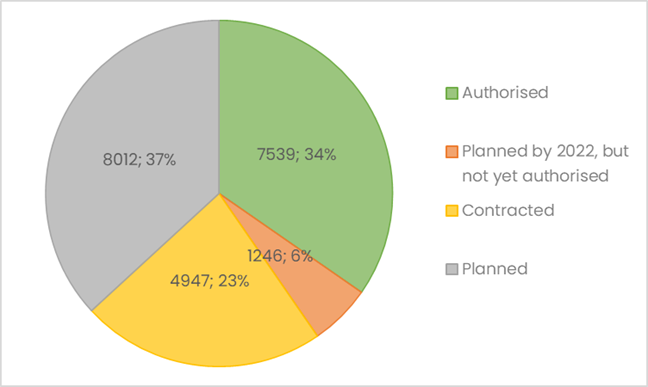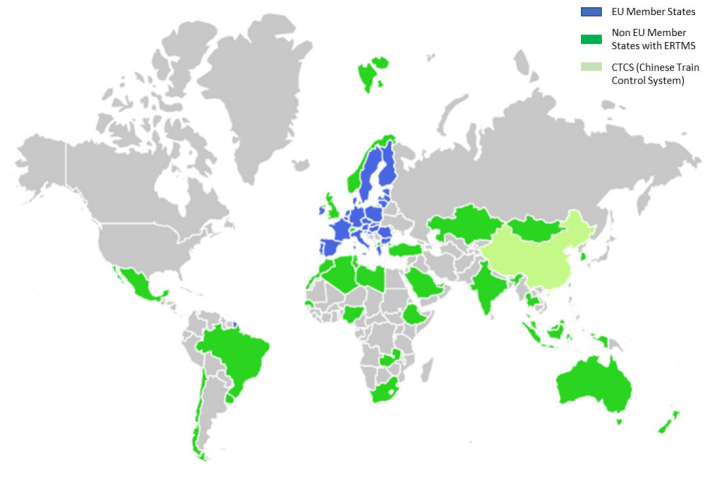Mature and stable ERTMS specifications have been introduced in commercial projects. Today there are mature and stable ERTMS technical specifications that are used in commercial projects all around Europe.
Any train equipped with the latest ERTMS version will be able to circulate throughout the different European sections equipped with ERTMS reference specifications.
ERTMS is in use in commercial projects across Europe.
European Corridors are the heart of the ERTMS deployment. ERTMS is now in a phase of deployment throughout Europe. To facilitate this process, a number of transport corridors have been selected as necessary for the early deployment of ERTMS.
There is a positive business case for ERTMS on all core network corridors according to the “ERTMS business case on the 9 core network corridors” document, provided that both trackside and on-board are deployed in a coordinated way. The results per corridor are relatively similar, although some differences can be observed, mainly due to the level of ERTMS deployed on each corridor, the national values used for trackside deployment and maintenance costs, the current status of the national fleet and traffic growth assumptions.
Matthias Ruete, the European coordinator for the ERTMS. Matthias Ruete, who took over from Karel Vinck in 2019, is the European ERTMS coordinator, working with the rail sector to further deploy ERTMS along the EU's rail network. The coordinator gives the necessary political impetus for the ERTMS project and the realisation of the MoU.
Trackside deployment
The current TEN-T Guidelines (Regulation (EU) No 1315/2013) establish ERTMS as one of the priorities for railway infrastructure development and set out a deadline for its deployment on the Core Network by 2030 and on the Comprehensive Network by 2050. In January 2017, based on the TEN-T Guidelines, the European Commission adopted the ERTMS European Deployment Plan (EDP). It sets out deadlines for deploying ERTMS on some sections of the Core Network Corridors (CNC) covering the 2017-2023 period. The number of km planned for each year in the EDP and the TEN-T Guidelines for the CNC are shown in the figure below.
The analysis of the progress made, measured against the 2017 EDP, is based on EU-27 alignment and does not cover sections of the CNC that were included by the CEF 2 Regulation.
Overall, it can be ascertained that 52% of the length planned in the EDP by the end of 2022 (i.e. 13 487km) was completed by end-February 2023. At the same time, 46% (or 7 152 km) of the 15 703 km planned to be put in operation by 2023, according to the EDP, have already been commissioned.
In July 2021, the CEF 2 Regulation extended the CNC by 9 680 km. In total, the length of the CNC, including CEF 2 extensions and excluding sections in the United Kingdom, amounts at present to 59 055 km.
At the end of February 2023, 15% of the revised CNC network (i.e. 59 055km) was in operation with ETCS (i.e. 8 600 km) and 61% with GSM-R. The following charts indicate the current ETCS status of the CNC sections, expected according to the EDP by 2023 (15 703 km) and the TEN-T Guidelines by 2030 (57 170 km), including CEF 2 extension and excluding UK sections, and taking into consideration exemptions.
There are 238 km already in operation that was not foreseen in the EDP to be put in operation before 2023, and an additional 1 210 km in operation on sections belonging to the CEF 2 extension. Sections belonging to the CEF 2 extension are, at present, not included in the current EDP.
According to the TEN-T Guidelines, CEF 2 sections belonging to the Core Network should be equipped by 2030 and the remaining CEF 2 sections by 2050.
Based on Member State data, 13 992 km on the CNC are planned to be equipped with ETCS by 2023, although the EDP requires only 10 954 km of them to be equipped by 2023. By 2030, Member States plan to have ETCS in operation on a total of 40 564 km on the CNC.
The following map presents the current status of the ETCS deployment on the CNC. The dotted lines are those added to the CNC by the CEF 2 extension. According to TEN-T Guidelines , the Irish network and lines that do not belong to Rail Baltica in Estonia, Latvia, and Lithuania are exempt from the obligation to fully deploy ERTMS.
Regarding the GSM-R deployment, there are 36 025 km equipped with GSM-R on the CNC (61%) and an additional 7 388 km are already covered by contracts signed with suppliers (13%). Out of the nine CNC, the most advanced in terms of GSM-R deployment is RALP, with 99% of its length already equipped, while GSM-R deployment on other corridors ranges between 39% and 93%.
The deployment of GSM-R per corridor is presented in the graph below.
ETCS status by corridor – Short Term (2023)
The ETCS status on CNC expressed in terms of number and percentage of km to be equipped by 2023 is compiled below by corridor. The CNC with the highest number of km to be equipped by 2023 are highlighted in purple:
The CNC with the highest number of km to be deployed by 2023 are MED, OEM and RALP. Their “ETCS in operation” rates are 54%, 34% and 47%, respectively. Nevertheless, when taking into account the km of sections in operation and under construction, the rate increases to 99% for RDN, 99% for RALP and 98% for BAC corridors. SCM corridor with 71% has the lowest “ETCS in operation and ETCS under construction” rate of all corridors. The NSM corridor is the only one in which all their sections planned by 2023 in the EDP are already operational or with projects signed, including the framework contracts.
ETCS status by corridor – Long Term (2030)
The ETCS status on CNC in terms of number and percentage of km to be equipped by 2030 is compiled below. The CNC with the highest number of km to be equipped by 2030 are highlighted in purple:
The CNC with the highest deployment rate are RALP (31%) and BAC (29%). The remaining CNC have a deployment rate between 10% and 19%. RDN and OEM have very low rates, although some lines on those CNC had been deployed with a pre-baseline 2, which is not a legal baseline anymore and is thus not taken into consideration for statistical reasons in the table above.
ETCS status by Member State - Short term (2023)
The ETCS status by Member State, and Norway and Switzerland, expressed in terms of number and percentage of km to be equipped on the CNC by 2023, is compiled below. Member States with the highest number of km to be equipped by 2023 are highlighted in purple.
ETCS was deployed on the whole network of Luxembourg at the end of 2017. The Netherlands has already finalised the deployment of the sections planned by 2023 as well. Switzerland has all its sections either deployed or under construction (only 3% pending), and operation without restrictions on the whole Swiss network was planned by 2021.
France has already 70% of the km planned in the EDP by 2023 in operation, and the remaining sections planned by 2023 are under construction.
France, Greece, Luxembourg, The Netherlands, Romania and Switzerland have their sections planned by 2023 in the EDP, either in operation or under construction. Bulgaria, Czechia, Germany, Hungry, Italy, Poland, Slovakia, Slovenia and Spain have an ETCS deployment progress rate (i.e. ETCS in operation or under construction) well above 80 %.
The ERTMS deployment in Denmark is the lowest by far. However, Denmark has two framework contracts covering all of its state-owned network with the aim to finalise the deployment on the entire network by 2030.
The progress rate for the deployment of ETCS in Austria (below 60 %) leaves a clear room for acceleration in order to meet the EDP deadlines. However, Austria has two framework contracts covering all the entire ETCS L2 trackside implementation.
Italy, Poland and Germany have a relatively low share of ETCS already in operation, which from an EU perspective would appear particularly critical in view of the length of the network.
ETCS status by Member State - Long term (2030)
The ETCS status by Member State, including Norway and Switzerland, expressed in terms of number and percentage of km to be equipped on CNC by 2030, is compiled below. The Member States with the highest number of km to equip are highlighted in purple:
For the Member States with the highest number of km to be deployed, the ETCS in operation rate is generally low (9 % in France, 3% in Germany, 11% in Italy, 18% in Poland, 22% in Spain, 13% in Sweden). Nevertheless, when considering the km of sections under construction and in operation, these percentages increase to 16%, 23%, 43%, 46%, 39%, 25%, respectively. Additional deployment efforts should be made in these Member States, especially in France and Germany, which have the lowest ETCS status rate.
In Ireland, there is no ETCS deployment yet. However, according to the latest Irish deployment plan, the Irish network will be equipped with ETCS Level 1 by 2040. In case of the Baltic States, the lines outside the Rail Baltica in Estonia, Latvia and Lithuania are at present exempted from the obligation to fully deploy ETCS.
As mentioned in the previous subsection, Belgium, Denmark, Norway, Sweden and Austria have all their railway sections included in framework contracts. Therefore, all their railway sections are considered to be either already in operation or at least covered by a contract.
On-board deployment
A successful ERTMS deployment plan requires a synchronised deployment strategy between trackside and on-board. Only when the fleet is equipped will be possible to reap the full benefits of the ERTMS deployment. As a result, a forecast of the total number of equipped vehicles is needed.
According to the data available until March 2023, 21 744 vehicles will be equipped with an interoperable ETCS version by 2030. Out of this projected number, 7 539 vehicles have already been equipped with ETCS. Additionally, 1 246 vehicles were initially planned to be equipped with ETCS by 2022, but no confirmation has been received regarding their commissioning. 4 947 vehicles are currently under contract for ETCS installation, while 8 012 vehicles are planned for future ERTMS implementation, pending the signing of contracts between the supplier and the owner. The graph below illustrates the status of the ETCS on-board deployment on vehicles expected to be equipped by 2030.
Deployment outside the EU
More than 53 000 km of ERTMS railway lines and 5 900 vehicles are in service or have been contracted outside Europe. A vast majority of the ERTMS lines located outside Europe are new lines. Deploying ERTMS is indeed technically simpler and faster in green field projects. The following map shows the non-EU countries which have ERTMS installed or planned in the future.


